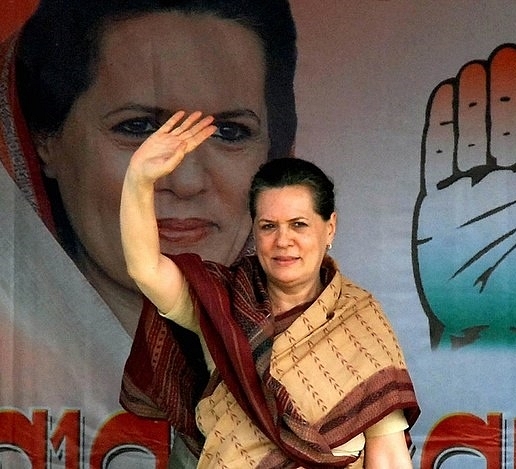
Congress’ GST U-Turn: Why It Purred Like A Cat After Roaring Like A Tiger
Behind the Congress party’s U-turn on the Goods & Services Tax (GST), where it went from extreme obstructionism to reasonable cooperation, lies its new political calculations.
The fact that the Congress voted fully for the constitutional amendment bill, when it was in a position to queer the pitch by raising a ruckus or insisting on an amendment, shows that it has thought through its future options.
Behind the Congress party’s
U-turn on the Goods & Services Tax (GST), where it went from extreme
obstructionism to reasonable cooperation, lies its new political calculations. With
most states on board, the Congress ran the risk of alienating potential state
allies by obstructing GST’s further progress. Also, having been cornered by Narendra
Modi’s efforts to paint the party as anti-poor for opposing GST reform, the
Congress decided to cut its losses, knowing full well that it still holds
reasonably high cards.
This much was apparent in P
Chidambaram’s two politically-laden references to the GST rate: he insisted
that 18 percent should be the absolute outer limit for a combined standard GST rate
in the name of shielding the aam aadmi
from regressive taxes and inflation; he also demanded an assurance from the
Finance Minister that the actual Bill to levy a goods and services tax (the
Bill passed on 3 August by the Rajya Sabha was the constitutional amendment
bill, and only an enabler of GST) should not be tabled as a money bill.
This was a transparent
attempt to force Arun Jaitley to accept an unrealistic demand, thus leaving the
Congress with the possibility of holding up the GST bill in the Rajya Sabha
when it comes up in November. As for the 18 percent cap, even though it is
desirable, it may not be possible in the context of the central assurance of
full compensation for any short-term revenue losses to states.
An 18 percent
cap may have trapped Jaitley into either abandoning the fiscal roadmap in case
revenues did not rise to the occasion, or denying states their compensation,
thus politically cornering the BJP on the eve of the 2019 general elections.
Chidambaram knows this for sure, since he managed to deny states compensation for the abolition of central sales tax (CST) after state-level value-added tax (VAT) came into existence. States used his failure to compensate CST losses by blocking progress on GST. Chidambaram had to eat crow and pay up. He hopes the BJP will be similarly embarrassed when it too struggles to compensate states.
Luckily, Jaitley did not fall
for Chidambaram’s bait, and declined to promise either the 18 percent cap, or
the routing of the GST bill as a money bill, which would give the Rajya Sabha a
veto. And the fact that the Congress still voted fully for the constitutional
amendment bill, when it was in a position to queer the pitch by raising a
ruckus or insisting on an amendment, shows that it has thought through its
future options.
While the GST constitutional amendment bill is through, the real challenge before the Modi government is in its implementation and subsequent political and financial management of this changeover.
This is where Congress will see a chance.
The first battle will be on the standard GST rate. If we take actual central tax rates (excise and service tax) and state VAT rates, not to speak of the state levies that will be subsumed into GST (octroi, entry tax, entertainment tax, luxury tax, etc), the effective current combined rates (centre and states) will vary from 22-30 percent depending on the products we are talking about.
Consider the math: after the imposition of the Krishi Kalyan Cess in the 2016-17 Union budget, the central service tax rate is already 15 percent. To this you have to add state value-added taxes, which range from zero to 12 percent for most goods, and even higher for luxury or non-merit goods. If we take an average VAT rates of five-six percent in states, we are essentially talking of a revenue-neutral GST rate of nearly 22 percent at the minimum, even excluding revenues like octroi and entry taxes that are forgone by municipal corporations.
This is why the Congress is insisting on 18 percent. No state is willing to accept this as the limit, and the BJP, in order to force states to accept as low a standard rate as possible, will enter conflict zones.
The chances are no state will agree to an 18 percent standard rate, and the best compromise will probably settle around 20 percent. The Congress will then claim it tried to protect consumers, and will blame the BJP for any short-term cost-push inflation. And the Reserve Bank will be constrained from cutting interest rates. A further economic slowdown and higher inflation is in Congress’ interests.
Not only that, if, god forbid, states end up with a revenue shortfall, the BJP will have to abandon its fiscal roadmap, where again the Congress will raise cain.
Another point of Congress’
re-entry into political muscle-flexing will be the inevitable friction between
governments and traders and small businesses, which will go through months of angst
and agony as they try to become GST-compliant.
One cannot rule out traders taking to the streets to confront the government, as the jewellery trade did when the budget imposed a one percent excise duty on gold jewellery in the run-up to GST. Now protests may expand to other categories of retailers. The Congress batted for jewellers and lost; it will seek more such opportunities to embarrass the government.
Then there is also the opportunity to raise a furore over the loss of revenues in municipal bodies, or even in states.
The Congress knows it has comeback opportunities in the long GST implementation period. Hence its U-turn.